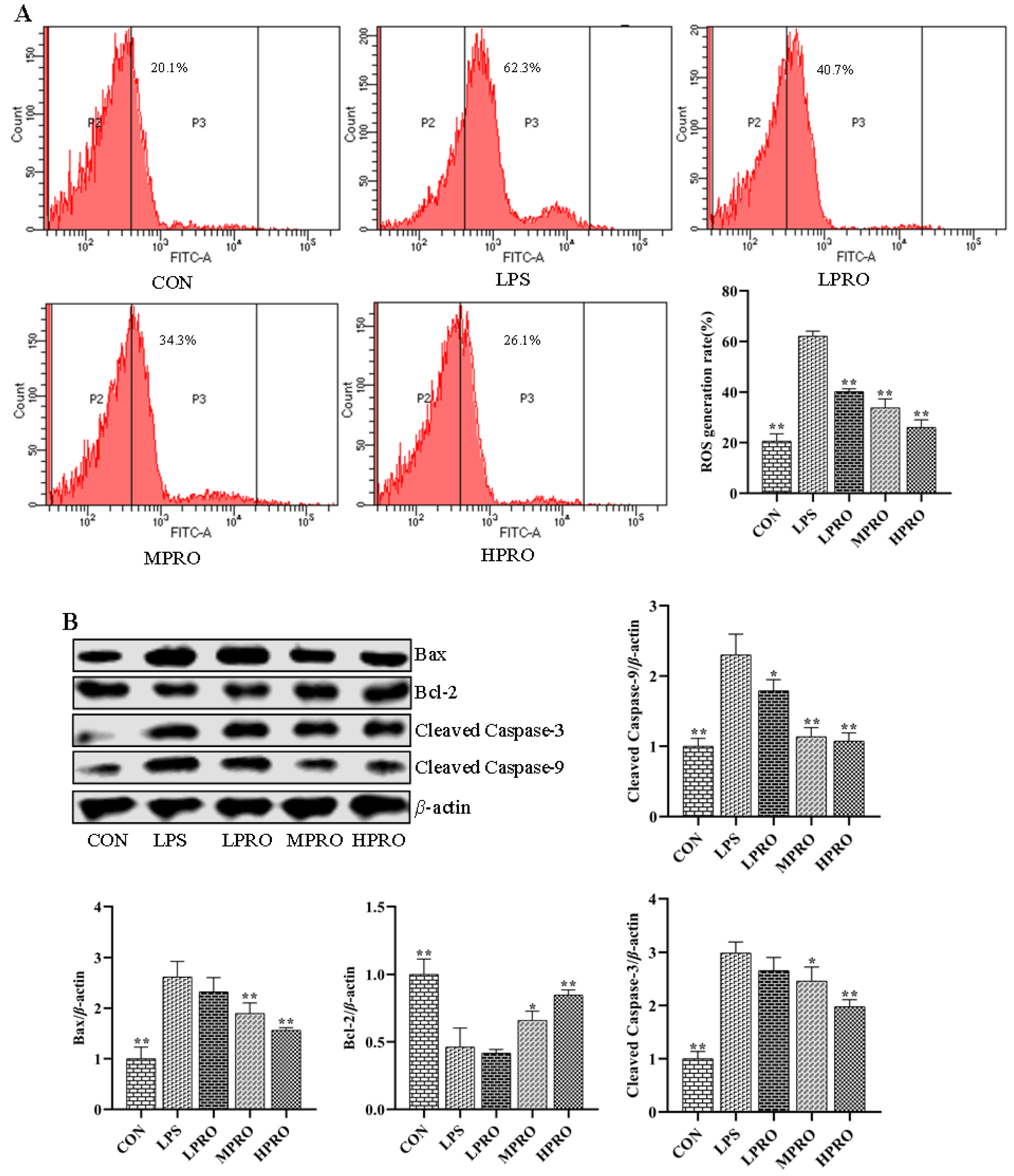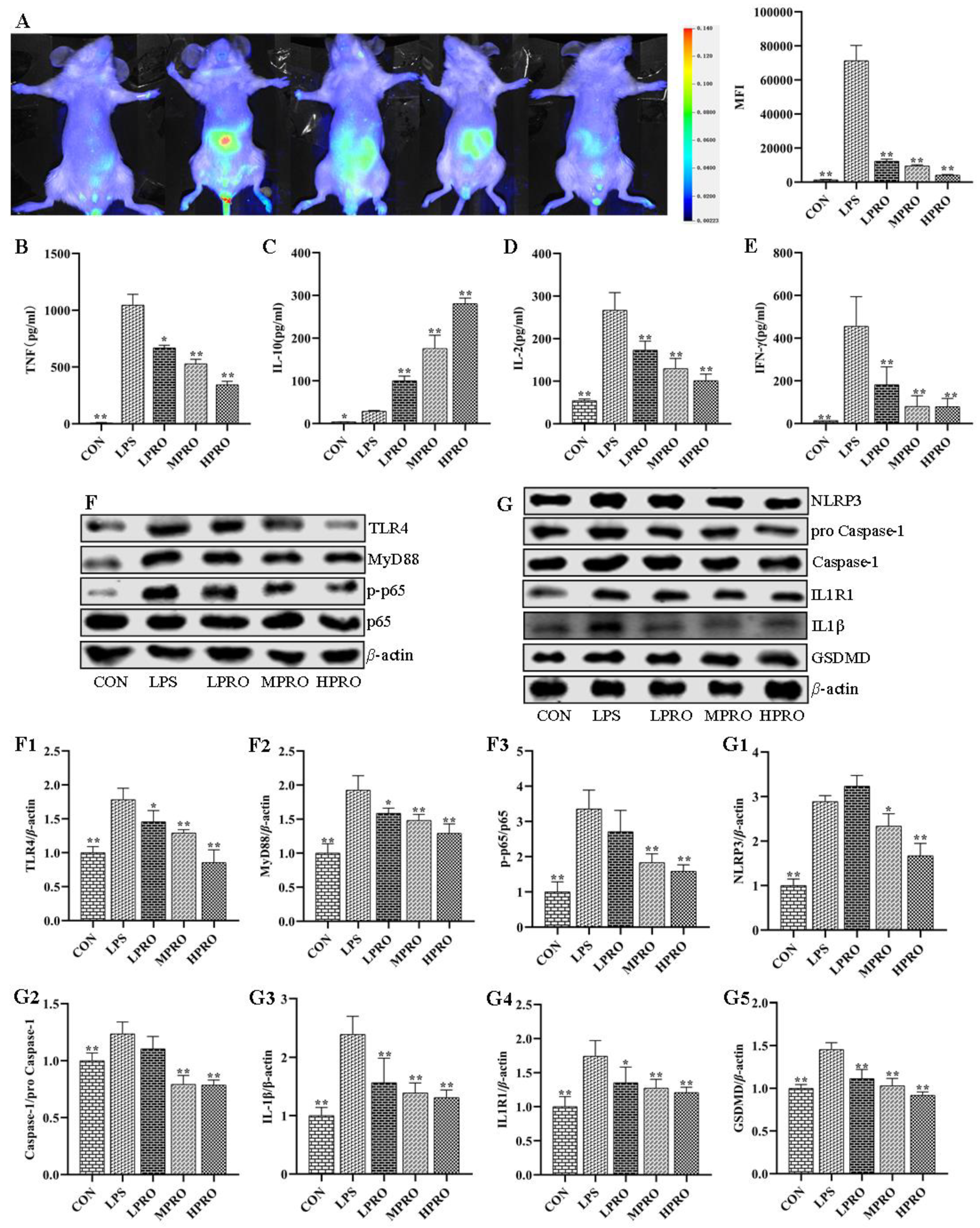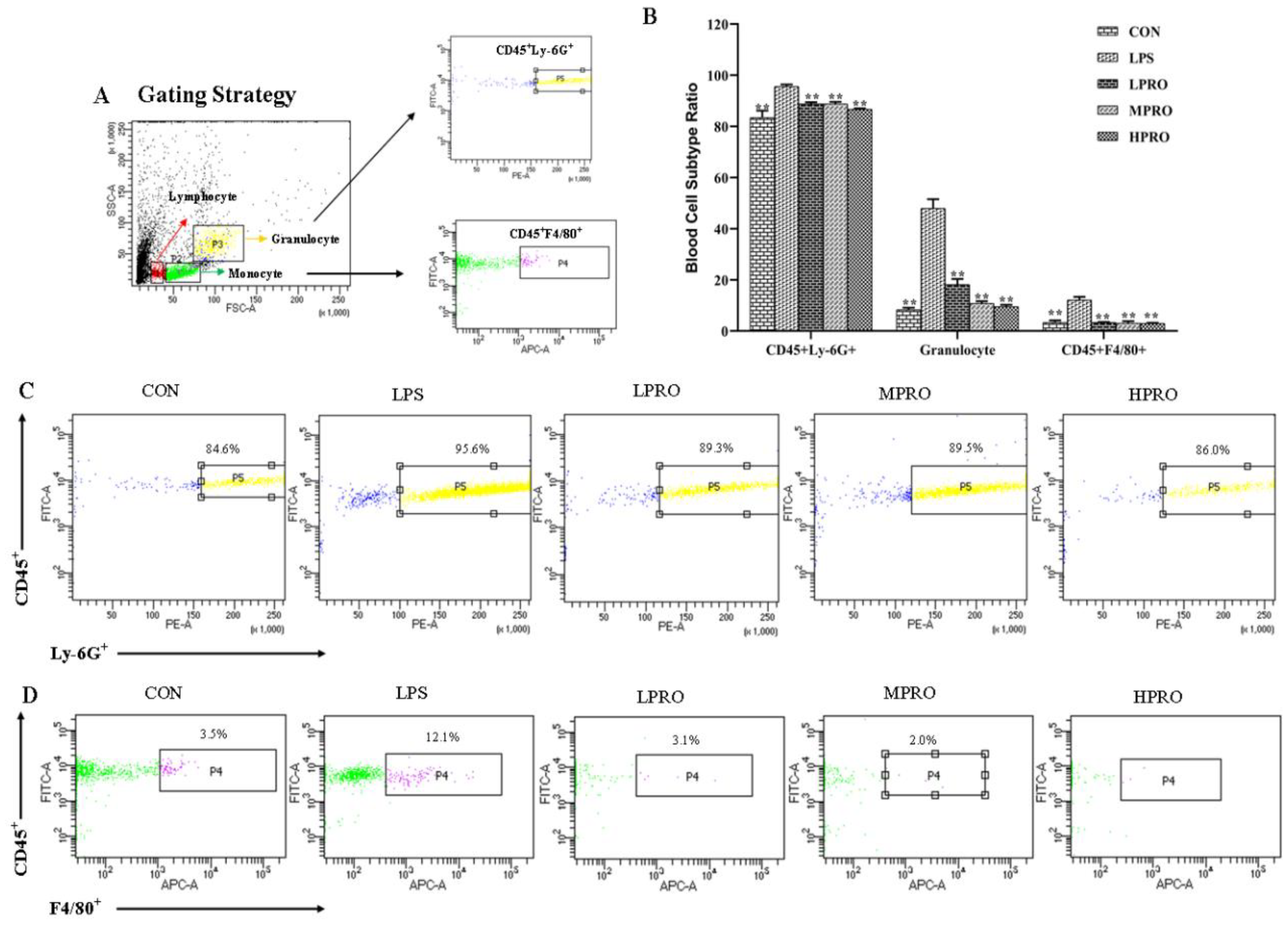Protopine Protects Mice against LPS-Induced Acute Kidney Injury by Inhibiting Apoptosis and Inflammation via the TLR4 Signaling Pathway
Abstract
1. Introduction
2. Results
2.1. Compound Identification and Structural Elucidation
2.2. Effects of Protopine on the Renal Function in Mice with LPS-Induced AKI
2.3. Effects of Protopine on Apoptosis in Mice with LPS-Induced AKI
2.4. Effects of Protopine on Inflammation in Mice with LPS-Induced AKI
2.5. Effects of Protopine on the White Blood Cell Subtype in Peripheral Blood of Mice with LPS-Induced AKI
3. Discussion
4. Materials and Methods
4.1. General Experimental Procedure
4.2. Plant Materials
4.3. Extraction and Isolation
4.4. LPS-Induced AKI In Vivo
4.5. Flow Cytometry Analysis of White Blood Cell Subtype
4.6. Primary Kidney Cells and Analysis of ROS
4.7. Cytometric Bead Array Assay
4.8. Assessments of Biochemical Parameters
4.9. Histomorphological Examination
4.10. Western Blot Analysis
4.11. Statistical Analysis
5. Conclusions
Author Contributions
Funding
Acknowledgments
Conflicts of Interest
Abbreviations
| C. humosa Migo | Corydalis humosa Migo |
| PRO | protopine |
| LPS | lipopolysaccharide |
| AKI | acute kidney injury |
| BUN | blood urea nitrogen |
| Scr | serum creatinine |
| TNF | tumor necrosis factor |
| IL-2 | interleukin-2 |
| IFN-γ | interferon-γ |
| IL-10 | interleukin-10 |
| ROS | reactive oxygen species |
| TLR4 | toll-like receptor 4 |
| NLRP3 | nod receptor heat protein domain associated protein 3 |
| NMR | nuclear magnetic resonance |
| TMS | tetramethylsilane |
| DMSO | dimethyl sulfoxide |
| FITC | fluoresceine isothiocyanate |
| H&E | hematoxylin and eosin |
| Bax | associated X protein |
| Bcl-2 | B-cell lymphoma 2 |
| CBA | cytometric bead array |
| IL-1β | interleukin-1β |
| IL1R1 | interleukin-1 receptor 1 |
| GSDMD | gasdermin |
| MyD88 | myeloiddifferentiationfactor88 |
References
- Quoilin, C.; Mouithys-Mickalad, A.; Lecart, S.; Fontaine-Aupart, M.-P.; Hoebeke, M. Evidence of oxidative stress and mitochondrial respiratory chain dysfunction in an in vitro model of sepsis-induced kidney injury. Biochim. Et Biophys. Acta (BBA) - Bioenerg. 2014, 1837, 1790–1800. [Google Scholar] [CrossRef]
- Bilgili, B.; Haliloglu, M.; Cinel, I. Sepsis and Acute Kidney Injury. Turk. J. Anesth. Reanim. 2014, 42, 294–301. [Google Scholar] [CrossRef]
- Robert, S.W.; Wang, W. Acute renal failure and sepsis. N. Engl. J. Med. 2004, 351, 159–169. [Google Scholar]
- Zarjou, A.; Agarwal, A. Sepsis and acute kidney injury. J. Am. Soc. Nephrol. 2011, 22, 999–1006. [Google Scholar] [CrossRef] [PubMed]
- Choudhary, G.S.; Al-Harbi, S.; Almasan, A. Caspase-3 activation is a critical determinant of genotoxic stress-induced apoptosis. Methods Mol. Biol. 2015, 1219, 1–9. [Google Scholar] [PubMed]
- Nair, A.R.; Masson, G.S.; Ebenezer, P.J.; Del Piero, F.; Francis, J. Role of TLR4 in lipopolysaccharide-induced acute kidney injury: Protection by blueberry. Free. Radic. Biol. Med. 2014, 71, 16–25. [Google Scholar] [CrossRef] [PubMed]
- Rosenthal, M.D.; Moore, F.A. Persistent Inflammation, Immunosuppression, and Catabolism: Evolution of Multiple Organ Dysfunction. Surg. Infect. 2016, 17, 167–172. [Google Scholar] [CrossRef]
- Mariappan, N.; Soorappan, R.N.; Haque, M.; Sriramula, S.; Francis, J. TNF-α-induced mitochondrial oxidative stress and cardiac dysfunction: Restoration by superoxide dismutase mimetic Tempol. Am. J. Physiol. Circ. Physiol. 2007, 293, H2726–H2737. [Google Scholar] [CrossRef]
- Elks, C.M.; Mariappan, N.; Haque, M.; Guggilam, A.; Majid, D.S.; Francis, J. Chronic NF-kappaB blockade reduces cytosolic and mitochondrial oxidative stress and attenuates renal injury and hypertension in SHR. Am. J. Physiol. Ren. Physiol. 2009, 296, F298–F305. [Google Scholar] [CrossRef]
- Abogresha, N.M.; Greish, S.M.; Abdelaziz, E.Z.; Khalil, W.F. Remote effect of kidney ischemia-reperfusion injury on pancreas: Role of oxidative stress and mitochondrial apoptosis. Arch. Med. Sci. 2016, 12, 252–262. [Google Scholar] [CrossRef]
- Li, J.; Gui, Y.; Ren, J.; Liu, X.; Feng, Y.; Zeng, Z.; He, W.; Yang, J.; Dai, C. Metformin Protects Against Cisplatin-Induced Tubular Cell Apoptosis and Acute Kidney Injury via AMPKα-regulated Autophagy Induction. Sci. Rep. 2016, 6, 23975. [Google Scholar] [CrossRef] [PubMed]
- Renz, H.; Herzum, I. Inflammatory markers in SIRS, sepsis and septic shock. Curr. Med. Chem. 2008, 15, 581–587. [Google Scholar] [CrossRef] [PubMed]
- Zhang, X.; Wang, C.; Shan, S.; Liu, X.; Jiang, Z.; Ren, T. TLR4/ROS/miRNA-21 pathway underlies lipopolysaccharide instructed primary tumor outgrowth in lung cancer patients. Oncotarget 2016, 7, 42172–42182. [Google Scholar] [CrossRef] [PubMed]
- Tao, J.H.; Zhang, X.Q.; Ye, W.C.; Zhao, S.X. Chemical Constituents from Corydalis humsoa. Chin. Herb. Med. 2005, 28, 556–557. [Google Scholar]
- Liu, C.; Zhao, S.X. Chemical constituents of Corydalis Humosa. J. China Pharm. Univ. 1989, 20, 261–265. [Google Scholar]
- Alam, M.B.; Ju, M.-K.; Kwon, Y.-G.; Lee, S.H. Protopine attenuates inflammation stimulated by carrageenan and LPS via the MAPK/NF-κB pathway. Food Chem. Toxicol. 2019, 131, 110583. [Google Scholar] [CrossRef]
- Wang, G.-X.; Zhou, Z.; Jiang, D.-X.; Han, J.; Wang, J.-F.; Zhao, L.-W.; Li, J. In vivo anthelmintic activity of five alkaloids from Macleaya microcarpa (Maxim) Fedde against Dactylogyrus intermedius in Carassius auratus. Vet. Parasitol. 2010, 171, 305–313. [Google Scholar] [CrossRef]
- Kosina, P.; Gregorova, J.; Gruz, J.; Vacek, J.; Kolar, M.; Vogel, M.; Roos, W.; Naumann, K.; Simanek, V.; Ulrichova, J. Phytochemical and antimicrobial characterization of Macleaya cordata herb. Fitoterapia 2010, 81, 1006–1012. [Google Scholar] [CrossRef]
- Rathi, A.; Srivastava, A.K.; Shirwaikar, A.; Rawat, A.K.S.; Mehrotra, S. Hepatoprotective potential of Fumaria indica Pugsley whole plant extracts, fractions and an isolated alkaloid protopine. Phytomedicine 2008, 15, 470–477. [Google Scholar] [CrossRef]
- Yamada, T.; Ishikawa, S.; Kataoka, S.; Uda, T.; Iinuma, Y.; Hattori, R.; Yamada, T.; Morikawa, M.; Kaneuchi, M.; Minakami, H. Coagulation/Fibrinolysis and laboratory characteristics of pregnant women with severely depressed antithrombin activity. Hypertens. Pregnancy 2013, 32, 235–244. [Google Scholar] [CrossRef]
- Aksu, U.; Ergin, B.; Bezemer, R.; Kandil, A.; Milstein, D.M.J.; Demirci-Tansel, C.; Ince, C. Scavenging reactive oxygen species using tempol in the acute phase of renal ischemia/reperfusion and its effects on kidney oxygenation and nitric oxide levels. Intensiv. Care Med. Exp. 2015, 3, 57. [Google Scholar] [CrossRef] [PubMed]
- Harjai, M.; Bogra, J.; Kohli, M.; Pant, A.B. Is suppression of apoptosis a new therapeutic target in sepsis. Anaesth Intensive Care 2013, 41, 175–183. [Google Scholar] [CrossRef] [PubMed]
- Uchida, T.; Ito, S.; Kumagai, H.; Oda, T.; Nakashima, H.; Seki, S. Roles of Natural Killer T Cells and Natural Killer Cells in Kidney Injury. Int. J. Mol. Sci. 2019, 20, 2487. [Google Scholar] [CrossRef]
- Mortensen, J.; Shames, B.; Johnson, C.P.; Nilakantan, V. MnTMPyP, a superoxide dismutase/catalase mimetic, decreases inflammatory indices in ischemic acute kidney injury. Inflamm Res. 2011, 60, 299–307. [Google Scholar] [CrossRef]
- Cunningham, P.N.; Dyanov, H.M.; Park, P.; Wang, J.; Newell, K.A.; Quigg, R.J. Acute renal failure in endotoxemia is caused by TNF acting directly on TNF receptor-1 in kidney. J. Immunol. 2002, 168, 5817–5823. [Google Scholar] [CrossRef]
- Mian, M.O.R.; He, Y.; Bertagnolli, M.; Mai-Vo, T.A.; Fernandes, R.O.; Boudreau, F.; Cloutier, A.; Luu, T.M.; Nuyt, A.M. TLR (Toll-Like Receptor) 4 Antagonism Prevents Left Ventricular Hypertrophy and Dysfunction Caused by Neonatal Hyperoxia Exposure in Rats. Hypertension 2019, 74, 843–853. [Google Scholar] [CrossRef]
- Jia, S.-J.; Niu, P.-P.; Cong, J.-Z.; Zhang, B.-K.; Zhao, M. TLR4 signaling: A potential therapeutic target in ischemic coronary artery disease. Int. Immunopharmacol. 2014, 23, 54–59. [Google Scholar] [CrossRef]
- Teo, J.D.; Macary, P.A.; Tan, K.S. Pleiotropic effects of Blastocystis spp. Subtypes 4 and 7 on ligand-specific toll-like receptor signaling and NF-kappaB activation in a human monocyte cell line. PLoS ONE 2014, 9, e89036. [Google Scholar] [CrossRef]
- Zhang, K.; Jiao, X.F.; Li, J.X.; Wang, X.W. Rhein inhibits lipopolysaccharide-induced intestinal injury during sepsis by blocking the toll-like receptor 4 nuclear factor-kappaB pathway. Mol. Med. Rep. 2015, 12, 4415–4421. [Google Scholar] [CrossRef]
- Alvero, A.B. Recent insights into the role of NF-kappaB in ovarian carcinogenesis. Genome Med. 2010, 2, 56. [Google Scholar] [CrossRef]
- Benzer, F.; Kandemir, F.M.; Kucukler, S.; Comaklı, S.; Caglayan, C. Chemoprotective effects of curcumin on doxorubicin-induced nephrotoxicity in wistar rats: By modulating inflammatory cytokines, apoptosis, oxidative stress and oxidative DNA damage. Arch. Physiol. Biochem. 2018, 124, 1–10. [Google Scholar] [CrossRef]
- Tschopp, J.; Schroder, K. NLRP3 inflammasome activation: The convergence of multiple signalling pathways on ROS production? Nat. Rev. Immunol. 2010, 10, 210–215. [Google Scholar] [CrossRef]
- Vilaysane, A.; Chun, J.; Seamone, M.E.; Wang, W.; Chin, R.; Hirota, S.; Li, Y.; Clark, S.A.; Tschopp, J.; Trpkov, K.; et al. The NLRP3 inflammasome promotes renal inflammation and contributes to CKD. J. Am. Soc. Nephrol. 2010, 21, 1732–1744. [Google Scholar] [CrossRef]
- Martinon, F.; Mayor, A.; Tschopp, J. The Inflammasomes: Guardians of the Body. Annu. Rev. Immunol. 2009, 27, 229–265. [Google Scholar] [CrossRef]
- Laetitie, A.; Fabio, M.; Kimberly, B.; Michael, F.M.; Philip, N.H.; Jurg, T. NALP3 Forms an IL-1β-Processing Inflammasome with Increased Activity in Muckle-Wells Autoinflammatory Disorder. Immunity 2004, 20, 319–325. [Google Scholar]
- Kohsuke, T.; Hideki, H. The Inflammasome and Its Regulation. Crit. Rev. Immunol. 2014, 34, 41–80. [Google Scholar]
- Shi, J.; Zhao, Y.; Wang, K.; Shi, X.; Wang, Y.; Huang, H.; Zhuang, Y.; Cai, T.; Wang, F.; Shao, F. Cleavage of GSDMD by inflammatory caspases determines pyroptotic cell death. Nature 2015, 526, 660–665. [Google Scholar] [CrossRef]
- Kayagaki, N.; Stowe, I.B.; Lee, B.L.; O’Rourke, K.; Anderson, K.; Warming, S.; Cuellar, T.; Haley, B.; Roose-Girma, M.; Phung, Q.T.; et al. Caspase-11 cleaves gasdermin D for non-canonical inflammasome signalling. Nature 2015, 526, 666–671. [Google Scholar] [CrossRef]
Sample Availability: Not available. |





| NO. | δH | δC |
|---|---|---|
| 1a | 132.6 | |
| 1 | 6.94 (1H, s) | 107.2 |
| 2 | 147.2 | |
| 3 | 145.2 | |
| 4 | 6.79 (1H, s) | 106.2 |
| 4a | 135.9 | |
| 5 | 30.4 | |
| 6 | 57.3 | |
| 8 | 50.6 | |
| 8a | 118.2 | |
| 9 | 145.7 | |
| 10 | 145.1 | |
| 11 | 6.70 (1H, d, J = 8.0 Hz) | 110.3 |
| 12 | 6.66 (1H, d, J = 8.0 Hz) | 124.9 |
| 12a | 129.5 | |
| 13 | 46.0 | |
| 14 | 194.6 | |
| -OCH2O- | 5.95 (2H, s) | 100.6 |
| 5.98 (2H, s) | 101.0 | |
| N-CH3 | 1.81 (3H, s) | 41.0 |
© 2019 by the authors. Licensee MDPI, Basel, Switzerland. This article is an open access article distributed under the terms and conditions of the Creative Commons Attribution (CC BY) license (http://creativecommons.org/licenses/by/4.0/).
Share and Cite
Zhang, B.; Zeng, M.; Li, M.; Kan, Y.; Li, B.; Xu, R.; Wu, Y.; Wang, S.; Zheng, X.; Feng, W. Protopine Protects Mice against LPS-Induced Acute Kidney Injury by Inhibiting Apoptosis and Inflammation via the TLR4 Signaling Pathway. Molecules 2020, 25, 15. https://doi.org/10.3390/molecules25010015
Zhang B, Zeng M, Li M, Kan Y, Li B, Xu R, Wu Y, Wang S, Zheng X, Feng W. Protopine Protects Mice against LPS-Induced Acute Kidney Injury by Inhibiting Apoptosis and Inflammation via the TLR4 Signaling Pathway. Molecules. 2020; 25(1):15. https://doi.org/10.3390/molecules25010015
Chicago/Turabian StyleZhang, Beibei, Mengnan Zeng, Meng Li, Yuxuan Kan, Benke Li, Ruiqi Xu, Yuanyuan Wu, Shengchao Wang, Xiaoke Zheng, and Weisheng Feng. 2020. "Protopine Protects Mice against LPS-Induced Acute Kidney Injury by Inhibiting Apoptosis and Inflammation via the TLR4 Signaling Pathway" Molecules 25, no. 1: 15. https://doi.org/10.3390/molecules25010015
APA StyleZhang, B., Zeng, M., Li, M., Kan, Y., Li, B., Xu, R., Wu, Y., Wang, S., Zheng, X., & Feng, W. (2020). Protopine Protects Mice against LPS-Induced Acute Kidney Injury by Inhibiting Apoptosis and Inflammation via the TLR4 Signaling Pathway. Molecules, 25(1), 15. https://doi.org/10.3390/molecules25010015






